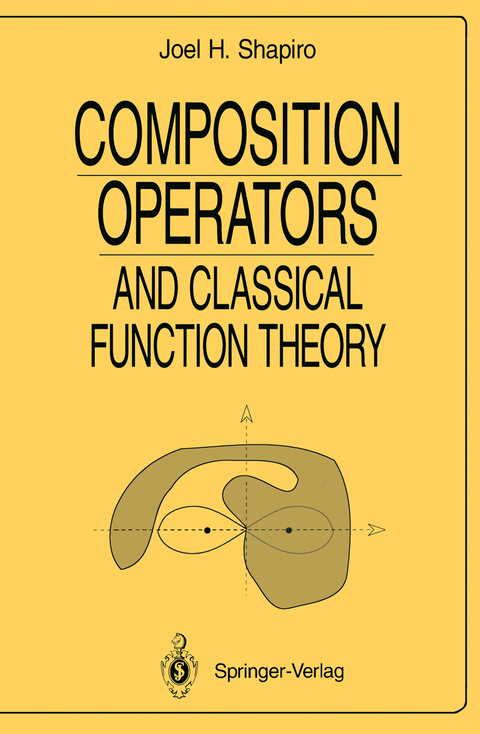
Composition Operators
Springer-Verlag New York Inc.
978-0-387-94067-0 (ISBN)
The study of composition operators links some of the most basic questions you can ask about linear operators with beautiful classical results from analytic-function theory. The process invests old theorems with new mean ings, and bestows upon functional analysis an intriguing class of concrete linear operators. Best of all, the subject can be appreciated by anyone with an interest in function theory or functional analysis, and a background roughly equivalent to the following twelve chapters of Rudin's textbook Real and Complex Analysis [Rdn '87]: Chapters 1-7 (measure and integra tion, LP spaces, basic Hilbert and Banach space theory), and 10-14 (basic function theory through the Riemann Mapping Theorem). In this book I introduce the reader to both the theory of composition operators, and the classical results that form its infrastructure. I develop the subject in a way that emphasizes its geometric content, staying as much as possible within the prerequisites set out in the twelve fundamental chapters of Rudin's book. Although much of the material on operators is quite recent, this book is not intended to be an exhaustive survey. It is, quite simply, an invitation to join in the fun. The story goes something like this.
0 Linear Fractional Prologue.- 0.1 First Properties.- 0.2 Fixed Points.- 0.3 Classification.- 0.4 Linear Fractional Self-Maps of U.- 0.5 Exercises.- 1 Littlewood’s Theorem.- 1.1 The Hardy Space H2.- 1.2 H2 via Integral Means.- 1.3 Littlewood’s Theorem.- 1.4 Exercises.- 1.5 Notes.- 2 Compactness: Introduction.- 2.1 Compact Operators.- 2.2 First Class of Examples.- 2.3 A Better Compactness Theorem.- 2.4 Compactness and Weak Convergence.- 2.5 Non-Compact Composition Operators.- 2.6 Exercises.- 2.7 Notes.- 3 Compactness and Univalence.- 3.1 The H2 Norm via Area Integrals.- 3.2 The Theorem.- 3.3 Proof of Sufficiency.- 3.4 The Adjoint Operator.- 3.5 Proof of Necessity.- 3.6 Compactness and Contact.- 3.7 Exercises.- 3.8 Notes.- 4 The Angular Derivative.- 4.1 The Definition.- 4.2 The Julia-Carathéodory Theorem.- 4.3 The Invariant Schwarz Lemma.- 4.4 A Boundary Schwarz Lemma.- 4.5 Proof that (JC 1) ?(JC 2).- 4.6 Proof that (JC 2) ?(JC 3).- 4.7 Angular derivatives and contact.- 4.8 Exercises.- 4.9 Notes.- 5 Angular Derivatives and Iteration.- 5.1 Statement of Results.- 5.2 Elementary Cases.- 5.3 Wolff’s Boundary Schwarz Lemma.- 5.4 Contraction Mappings.- 5.5 Grand Iteration Theorem, Completed.- 5.6 Exercises.- 5.7 Notes.- 6 Compactness and Eigenfunctions.- 6.1 Königs’s Theorem.- 6.2 Eigenfunctions for Compact C?.- 6.3 Compactness vs. Growth of ?.- 6.4 Compactness vs. Size of ? (U).- 6.5 Proof of Riesz’s Theorem.- 6.6 Exercises.- 6.7 Notes.- 7 Linear Fractional Cyclicity.- 7.1 Hypercyclic Fundamentals.- 7.2 Linear Fractional Hypercyclicity.- 7.3 Linear Fractional Cyclicity.- 7.4 Exercises.- 7.5 Notes.- 8 Cyclicity and Models.- 8.1 Transferenc from Models.- 8.2 From Maps to Models.- 8.3 A General Hypercyclicity Theorem.- 8.4 Exercises.- 8.5 Notes.- 9 Compactnessfrom Models.- 9.1 Review of Königs’s Model.- 9.2 Motivation.- 9.3 Main Result.- 9.4 The Hyperbolic Distance on U.- 9.5 The Hyperbolic Distance on G.- 9.6 Twisted Sectors.- 9.7 Main Theorem: Down Payment.- 9.8 Three Lemmas.- 9.9 Proof of the No-Sectors Theorem.- 9.10 Exercises.- 9.11 Notes.- 10 Compactness: General Case.- 10.1 Motivation.- 10.2 Inadequacy of Angular Derivatives.- 10.3 Non-Univalent Changes of Variable.- 10.4 Decay of the Counting Function.- 10.5 Proof of Sufficiency.- 10.6 Averaging the Counting Function.- 10.7 Proof of Necessity.- 10.8 Exercises.- 10.9 Notes.- Epilogue.- References.- Symbol Index.- Author Index.
| Reihe/Serie | Universitext | Universitext: Tracts in Mathematics |
|---|---|
| Zusatzinfo | 6 Illustrations, black and white; XVI, 223 p. 6 illus. |
| Verlagsort | New York, NY |
| Sprache | englisch |
| Maße | 155 x 235 mm |
| Themenwelt | Mathematik / Informatik ► Mathematik ► Analysis |
| ISBN-10 | 0-387-94067-7 / 0387940677 |
| ISBN-13 | 978-0-387-94067-0 / 9780387940670 |
| Zustand | Neuware |
| Haben Sie eine Frage zum Produkt? |
aus dem Bereich


